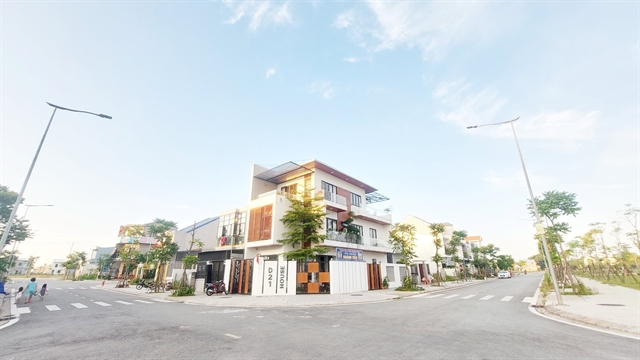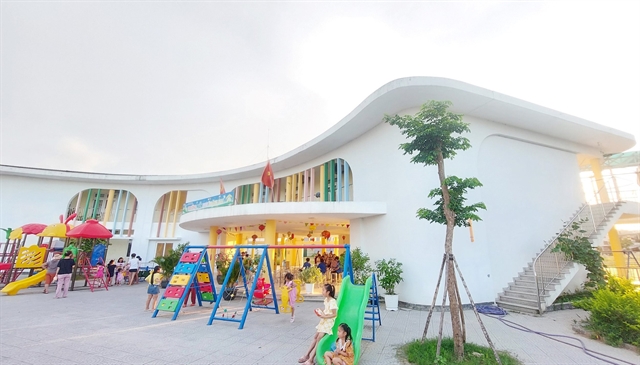 Society
Society

 |
| Bắc Hương Sơ resettlement area in Hương Sơ Ward, Huế City. — Photos baotainguyenmoitruong.vn |
THỪA THIÊN-HUẾ — At his house in Bắc Hương Sơ resettlement area, Võ Đình Nhật still can't believe he found such a great, new place to live.
A few years ago, the thought of living in his own home was nothing more than a dream.
The excitement can easily be seen on the faces of all those who have moved into the new houses. The struggles of poverty and hardship from the past, although not completely gone, the long sleepless nights in cramped houses are a thing of the past.
Experiencing the ups and downs of history, when the Nguyễn Dynasty ended in 1945, people migrated from many areas of Thừa Thiên-Huế and other provinces to live and build makeshift houses around the Citadel, seriously infringing upon the city’s relics.
But now, thousands of households living around the Huế Imperial Citadel over the past century have been relocated to the new resettlement areas, Tài Nguyên & Môi Trường (Natural Resources and Environment) online newspaper reported.
The "historic migration" in the land of the Imperial Citadel area has gradually become a reality in recent years.
Nhật says that he can never forget the days living in a temporary house in the city's relics.
The six members of his family struggled in a cramped house. It was called a house, but it was actually like a makeshift camp, with a living area of less than 20 square metres.
When they heard that the city authorities had a policy to support the relocation of the residents living in Thượng Thành (the protection wall surrounding the citadel) relics, his family did not hesitate. They took the lead in responding to this historic migration.
"My family was very poor," Nhật says.
"Now, we have been supported with a residential plot and a well-built house, so we are very happy. Now we have a new home and a stable living situation, everyone will work hard to improve their livelihoods and escape poverty."
Nguyễn Hoàng, 38, is also one of the pioneering families who handed over their premises to the city.
"For decades, we lived in the land of historical relics," Hoàng says.
"Facing with many difficulties, our family never ceased to dream of having a plot of land in our name and a solid house. And now, that wish has come true."
In the scorching heat of early summer, Hồ Thị Hoa, a 76-year-old woman living in the new resettlement area, says when they were still in the Thượng Thành relic, the entire family had to find somewhere else to escape the heat during hot days because it was unbearable to stay there. In rainy days, they were afraid of the rising water levels. Even now, whenever she thinks about their old place, she still shudders.
Life has truly become better since moving to the new place over a year ago, she says.
In 2019, a project on relocation and site clearance in the Imperial Citadel area was launched with two phases. The first phase implemented in the 2019-21 period focused on relocating people.
The provincial People's Committee called for support from donors, agencies and organisations to build new houses for the poor households who can't afford to build their own homes.
The Bắc Hương Sơ resettlement area is continuing to improve its infrastructure. It has a well-built kindergarten, electrical, water, and telecommunications systems, plants, interconnected roads and parks creating a modern and bustling area.
The majority of people living on heritage land are impoverished and self-employed labourers. The daily hardships made them never dare to think of leaving that makeshift houses to live in a proper house.
According to chairman of the People's Committee of Huế City Võ Lê Nhật, the relocation project has been actively implemented by the city, ensuring a better life for the people.
After more than three years since Phase 1, the People's Committee of Huế City has completed the relocation of 3,187 people living at Thượng Thành, Eo Bầu and Hộ Thành Hào relic sites.
 |
| The newly-built kindergarten in Bắc Hương Sơ resettlement area. |
The Bắc Hương Sơ resettlement area has implemented and completed technical infrastructure on a scale of 83.7 hectares. The project implementation process ensures democracy, transparency, and clarity, ensuring fair compensation, resettlement support, and maximises the rights and interests of relocated residents.
"The province and Huế City have made every effort to overcome difficulties and obstacles for the people in the project. The project continues to be implemented with great determination," the city chairman says.
"The main goal is to provide favourable conditions for the people to have stable and better living, ensuring conditions for long-term development of their livelihoods, and promoting local economy."
Initially, many families living in the heritage sites were uncertain about how to make a living after moving to the new residential area. However, now they have stated that their livelihoods have gradually stabilised in the new location. Some have sought new jobs, while many others continue to work in their previous occupations.
Lê Kim Nam, chairman of the People's Committee of Hương Sơ Ward, says 29 households have built new houses, and many others are preparing to build houses.
"We understand the thoughts and aspirations of the residents and will create all necessary conditions for them to have employment opportunities. In the short term, we will help them have jobs at the Hương Sơ-An Hòa Industrial Park, and find other establishments and businesses that are in need of labourers," says Nam.
To restore the state and the inherent value of the Huế Imperial Citadel, the provincial authorities have implemented the relocation project with a total investment of over VNĐ4,000 billion.
Serving the project of relocation and site clearance in the Imperial Citadel area, Huế City has been building 10 resettlement areas with 3,419 land lots in Hương Sơ Ward for residents in Thượng Thành, Eo Bầu, Tịnh Tâm Lake, Thành Hào, Phong Lộ and Bình Đài relic areas. — VNS




